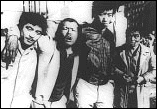|
|
 |
製作:横浜ドキュメントフィルム Production Company : Yokohama Document Film |
| 1981年。横浜の日雇労働者の街「寿町」では約4500人の単身男性、300人の女性、そして180人の子供たちが生活している。日雇い労務者たちは何の身分保障もなく、日々の雇用に明け暮れることに誇りさえ持っている。渡辺孝明、和田康の二人だけのスタッフはカメラと録音機を持ってこの街に入り込んだ。労務者たちの過酷な労働状況を捉えながら、彼等の過去が語られてゆく。労務者それぞれのインタビューからは小川プロで培った被写体との関係性を追求しようという方法論が活かされており映画は労務者たちの大宴会で結ばれる。『どっこい!人間節』のその後を、彼等なりに労務者それぞれの独立した世界として捉えようとしている。実際、監督の渡辺は小川プロが同じ寿町を撮った『どっこい!人間節寿・自由労働者の街』にスタッフとして参加し、その後『牧野物語・養蚕編』『牧野物語・峠』でも助監督を務めたが1978年に独立して演出家となった。本作品の後、渡辺は続編『寿ドヤ街・生きる2』そして在日朝鮮人の生活を追った『1985・川崎・熱い街』を経て1993年には『ALICE SANCTUARY』で劇映画にも乗り出している。 | Kotobuki-cho is a section of Yokohama whose residents consist of about 4500 single men, 300 women and 180 children. The day laborers living there have no secure social standing, but they do have one thing: pride in their daily work routine. With their camera and recorder in Kotobuki-cho, the minimal two-person staff of Watanabe Takaaki and Wada Yasushi filmed the often harsh working conditions of the day laborers, while taking in the stories of the workers themselves. The filmmakers decide to conduct a series of interviews following the methodology fostered by Ogawa Productions. This method emphasizes their relation to the film's objects of study. The film in fact ends with a huge banquet put on for the laborers. Watanabe had previously been on the staff of Ogawa Productions' A Song of the Bottom ( " Dokkoi ningen bushi, " 1975), and had served as assistant director on Magino Story--Raising Silkworms ( " Magino monogatari--yosanhen, " 1977), and Magino Story--Pass ( " Magino monogatari--toge, " 1977). Following A Song of the Bottom, Watanabe set out to film the various independent worlds of the laborers. He then began his own independent productions in 1978. Following Living on Kotobuki Street, Watanabe went on to do a follow-up film, Living on Kotobuki Street II ( "Kotobuki doya gai--ikiru II, " 1984); and a documentary which dealt with the daily lives of resident Koreans, 1985--Kawasaki--Burning Town ( " 1985--Kawasaki--atsui machi, " 1985). In 1993 he produced his first dramatic picture, Alice Sanctuary. |